
Gregory the Illuminator was the founder and first official head of the Armenian Apostolic Church. He converted Armenia from Zoroastrianism to Christianity in the early fourth century, making Armenia the first state to adopt Christianity as its official religion. He is venerated as a saint in the Armenian Apostolic Church and in some other churches.

Bahram IV, was the Sasanian King of Kings of Iran from 388 to 399. He was likely the son and successor of Shapur III.

Shapur I was the second Sasanian King of Kings of Iran. The precise dating of his reign is disputed, but it is generally agreed that he ruled from 240 to 270, with his father Ardashir I as co-regent until the death of the latter in 242. During his co-regency, he helped his father with the conquest and destruction of the city of Hatra, whose fall was facilitated, according to Islamic tradition, by the actions of his future wife al-Nadirah. Shapur also consolidated and expanded the empire of Ardashir I, waged war against the Roman Empire, and seized its cities of Nisibis and Carrhae while he was advancing as far as Roman Syria. Although he was defeated at the Battle of Resaena in 243 by Roman emperor Gordian III, he was the following year able to win the Battle of Misiche and force the new Roman emperor Philip the Arab to sign a favorable peace treaty that was regarded by the Romans as "a most shameful treaty".
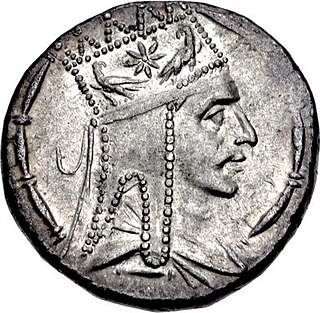
Armenia, also the Kingdom of Greater Armenia, or simply Greater Armenia or Armenia Major sometimes referred to as the Armenian Empire, was a kingdom in the Ancient Near East which existed from 331 BC to 428 AD. Its history is divided into the successive reigns of three royal dynasties: Orontid, Artaxiad and Arsacid (52–428).
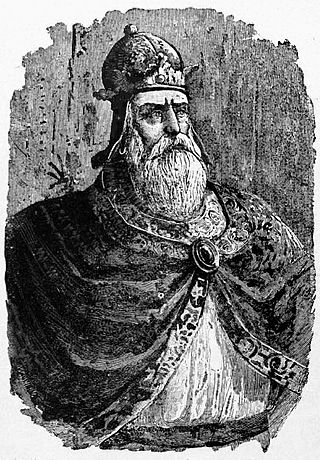
Tiridates III, also known as Tiridates the Great or Tiridates IV, was the Armenian Arsacid king from c. 298 to c. 330. In the early 4th century, Tiridates proclaimed Christianity as the state religion of Armenia, making the Armenian kingdom the first state to officially embrace Christianity.

Vologases V was King of Kings of the Parthian Empire from 191 to 208. As king of Armenia, he is known as Vologases II. Not much is known about his period of kingship of Armenia, except that he put his son Rev I on the Iberian throne in 189. Vologases succeeded his father Vologases IV as king of the Parthian Empire in 191; it is uncertain if the transition of power was peaceful or if Vologases took the throne in a civil war. When Vologases acceded the Parthian throne, he passed the Armenian throne to his son Khosrov I.
The Arsacid dynasty, called the Arshakuni (Արշակունի) in Armenian, ruled the Kingdom of Armenia from 12 to 428 AD. The dynasty was a branch of the Arsacid dynasty of Parthia. Arsacid kings reigned intermittently throughout the chaotic years following the fall of the Artaxiad dynasty until 62, when Tiridates I, brother of Parthian King Vologases I, secured Arsacid rule in Armenia as a client king of Rome. However, he did not succeed in establishing his line on the throne, and various princes of different Arsacid lineages ruled until the accession of Vologases II, who succeeded in establishing his own line on the Armenian throne, which ruled the kingdom until its abolishment by the Sasanian Empire in 428.

Tiridates I was King of Armenia beginning in 53 AD and the founder of the Arsacid dynasty of Armenia. The dates of his birth and death are unknown. His early reign was marked by a brief interruption towards the end of the year 54 and a much longer one from 58 to 63. In an agreement to resolve the Roman–Parthian conflict in and over Armenia, Tiridates I was crowned king of Armenia by the Roman emperor Nero in 66; in the future, the king of Armenia was to be a Parthian prince, but his appointment required approval from the Romans. Even though this made Armenia a client kingdom, various contemporary Roman sources thought that Nero had de facto ceded Armenia to the Parthian Empire.
Khosrov III the Small was the king of Arsacid Armenia c. 330–338/339.

Tiran known also as Tigranes VII, Tigranes or Diran was an Armenian prince who served as a Roman client king of Arsacid Armenia from 339 until 350. He was a contemporary of and is associated with the life of Sarkis the Warrior and his son, Martiros.
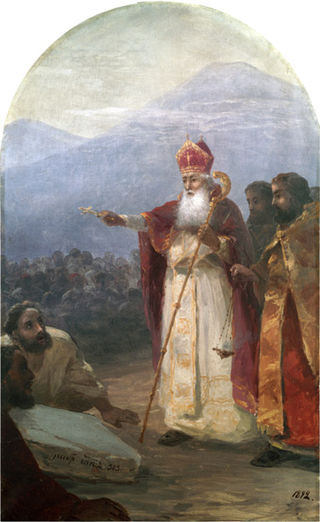
Christianity first spread to Armenia prior to the official adoption of the faith in the early fourth century, although the details are obscure. In the early fourth century, the Kingdom of Greater Armenia adopted Christianity as its state religion, becoming the first state to do so. The Arsacid king of Armenia at the time, Trdat, was converted by Gregory the Illuminator, who became the first head of the Armenian Church. The traditional date for the conversion of Armenia is 301, although many alternative dates have been proposed by scholars. While Armenia's church structure was established at this time, it took longer for Christianity to fully take root in the country. The greatest progress came after the invention of the Armenian alphabet by Mesrop Mashtots and the translation of the Bible and liturgy into Armenian in the fifth century.

Vramshapuh was a noble of the Arsacid dynasty who served as the Sasanian client king of Armenia from 389 until his death in 414. He is mainly remembered for presiding over the creation of the Armenian alphabet by Mesrop Mashtots.

Gaius Julius Sohaemus was a Roman client king of Armenia.
Khosrov I was a Parthian prince who served as a Roman client king of Armenia.
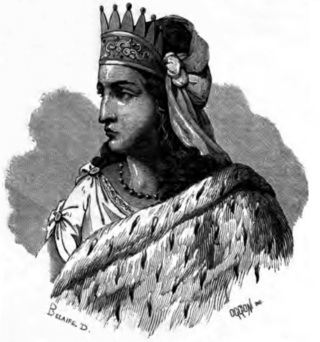
Khosrovidukht also transliterated Xosroviduxt was a princess of the Arsacid dynasty of Armenia, one of the client-kingdoms of the Roman Empire and a branch of the Arsacid dynasty of Parthia.

Ashkhen was the Queen of Armenia and a member of the Arsacid dynasty by marriage to King Tiridates III of Armenia.
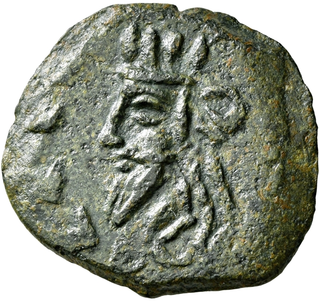
Tiridates II, flourished second half of the 2nd century - died 252), known in Armenian sources as Khosrov, was an Arsacid Prince who served as a Roman Client King of Armenia. Tiridates II was the son and heir of Khosrov I, king of Armenia.

Anak the Parthian was a Parthian noble who, according to the Armenian tradition, was the father of Gregory the Illuminator, who converted Armenia to Christianity in the early fourth century. Anak is said to have killed King Khosrov of Armenia at the incitement of the Sasanians, leading to his own murder and the extermination of his family, except for the child Gregory, who was saved and taken to Roman territory. The details and historicity of this account have been debated by historians.
Arsaces was an Armenian Prince of the Arsacid dynasty of Armenia who lived in the second half of the 4th century and possibly first half of the 5th century.















